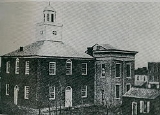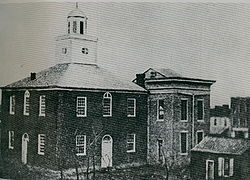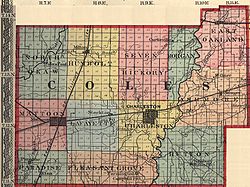
Charleston Riot
Encyclopedia
The Charleston Riot occurred on March 28, 1864, in Charleston
, Illinois
, after Union
soldiers and local Republicans
clashed with local insurgents known as Copperheads
. By the time the riot had subsided, nine were dead and twelve had been wounded.
 The news coverage of the event stated that the Peace Democrats were responsible for beginning the event. One such news source, from the Chicago Tribune
The news coverage of the event stated that the Peace Democrats were responsible for beginning the event. One such news source, from the Chicago Tribune
, later reprinted in the Charleston Courier, labeled Nelson Wells as the instigator of the conflict. Most articles published from the time, insist that the whole event transpired as a more spontaneous event and was not directly prompted by any one individual. The most likely explanation is that the event occurred because a sizable presence of both Copperheads
and Union
soldiers had been in town that day. Also many sources speculate that a sizable portion of the participants, at least on the side of the Peace Democrats, had been drinking quite heavily all day, and this led to the outbreak that resulted in the confrontation. At any rate, the fighting only lasted a few moments. But by the time the affair was over, the Copperheads had been run out of Charleston
. Rewards had been issued for the capture of any of those whom fled the scene. Included in those who left town, was John O’Hair, the leader of the Copperheads, who had been the sheriff of Coles County. Out of those killed, only two had been Copperheads, Nelson Wells and John Cooper; the other participants had been either captured or escaped. Other Union troops were called in from Mattoon
to assist the soldiers fighting in Charleston, but by the time their train arrived, none of the instigators were left in the town. Fifteen prisoners were eventually held for seven months, initially in Springfield, Illinois. President Lincoln, whose father and stepmother had lived in Coles County, waived the prisoners' right to Habeas Corpus and ordered their removal to Fort Delaware in the East. He ordered their release on November 4, 1864. Two of the prisoners had been indicted for murder and were exonerated by trial in December, 1864. Twelve other Copperheads had also been indicted for murder. They were never captured, and the indictments were nolled in May 1873.
The terms Copperheads and Butternuts were used to describe the larger movement, which has been known as Peace Democrats. This political affiliation which stirred up support, as David Montgomery points out in Beyond Equality: Labor and the Radical Republicans, by incorporating the fears that the federal government’s war effort sought to usurp the constitution. The copperheads incorporated a racial component to their disdain for the Northern war effort, as Montgomery points out, that emancipated Negroes would flood the North, because of the Emancipation Proclamation
. Using racially charged rhetoric
, Copperheads sought to unite opposition to the Radical Republicans. This had become a national phenomenon during the American Civil War
. Southern sympathizers were battling to keep their country from becoming, in their eyes, too radical.
 The Copperheads represented a political affiliation that was staunchly opposed to President Lincoln
The Copperheads represented a political affiliation that was staunchly opposed to President Lincoln
, the draft
, and abolition of slavery. This group favored an armistice to end the Civil War because they opposed the war itself. Most components of Copperhead ideology centered on the mistrust of the implications the war presented to American society. In particular, the aim to free the slaves had become an issue that some white natives of Illinois took issue with. The Civil War had split the country into factions, either side chose to support or oppose the aim to reincorporate the Southern states back into the Union. The Copperheads believed the Lincoln Administration had been out of line by abolishing slavery. Some citizens of Coles County accepted the ideology that it was not in the best interest of the country to free the slaves. Although the exact number is hard to gauge it has been estimated, by Victor Hicken in Illinois in the Civil War, that Coles County had been a significant pocket of Copperhead sympathizers. This idea is supported by the fact that John O’Hair, the leader of the Copperheads, had been the sheriff of Coles County during the Civil War.
In the end, the Charleston Riot provides a good example of how local events of Coles County history have fit into national currents as well. The Copperheads of Coles County had been different from other dissenting groups from around the country, in that they chose to use physical violence as their method of dissent. By killing Union soldiers, who had become the emblem of Federal government control, the Copperheads were attempting to project their anger toward the government. The draft, a strong central government, and racism fueled the Copperheads support within the county. In March 1864, these national tensions boiled over in the small town of Charleston, creating one of the most interesting events in the history of the county.
Charleston, Illinois
Charleston is a city in and the county seat of Coles County, Illinois, United States. The population was 21,838 as of the 2010 census. The city is home to Eastern Illinois University and has close ties with its neighbor Mattoon, Illinois...
, Illinois
Illinois
Illinois is the fifth-most populous state of the United States of America, and is often noted for being a microcosm of the entire country. With Chicago in the northeast, small industrial cities and great agricultural productivity in central and northern Illinois, and natural resources like coal,...
, after Union
Union (American Civil War)
During the American Civil War, the Union was a name used to refer to the federal government of the United States, which was supported by the twenty free states and five border slave states. It was opposed by 11 southern slave states that had declared a secession to join together to form the...
soldiers and local Republicans
Republican Party (United States)
The Republican Party is one of the two major contemporary political parties in the United States, along with the Democratic Party. Founded by anti-slavery expansion activists in 1854, it is often called the GOP . The party's platform generally reflects American conservatism in the U.S...
clashed with local insurgents known as Copperheads
Copperheads (politics)
The Copperheads were a vocal group of Democrats in the Northern United States who opposed the American Civil War, wanting an immediate peace settlement with the Confederates. Republicans started calling anti-war Democrats "Copperheads," likening them to the venomous snake...
. By the time the riot had subsided, nine were dead and twelve had been wounded.
Copperheads

Chicago Tribune
The Chicago Tribune is a major daily newspaper based in Chicago, Illinois, and the flagship publication of the Tribune Company. Formerly self-styled as the "World's Greatest Newspaper" , it remains the most read daily newspaper of the Chicago metropolitan area and the Great Lakes region and is...
, later reprinted in the Charleston Courier, labeled Nelson Wells as the instigator of the conflict. Most articles published from the time, insist that the whole event transpired as a more spontaneous event and was not directly prompted by any one individual. The most likely explanation is that the event occurred because a sizable presence of both Copperheads
Copperheads (politics)
The Copperheads were a vocal group of Democrats in the Northern United States who opposed the American Civil War, wanting an immediate peace settlement with the Confederates. Republicans started calling anti-war Democrats "Copperheads," likening them to the venomous snake...
and Union
Union (American Civil War)
During the American Civil War, the Union was a name used to refer to the federal government of the United States, which was supported by the twenty free states and five border slave states. It was opposed by 11 southern slave states that had declared a secession to join together to form the...
soldiers had been in town that day. Also many sources speculate that a sizable portion of the participants, at least on the side of the Peace Democrats, had been drinking quite heavily all day, and this led to the outbreak that resulted in the confrontation. At any rate, the fighting only lasted a few moments. But by the time the affair was over, the Copperheads had been run out of Charleston
Charleston, Illinois
Charleston is a city in and the county seat of Coles County, Illinois, United States. The population was 21,838 as of the 2010 census. The city is home to Eastern Illinois University and has close ties with its neighbor Mattoon, Illinois...
. Rewards had been issued for the capture of any of those whom fled the scene. Included in those who left town, was John O’Hair, the leader of the Copperheads, who had been the sheriff of Coles County. Out of those killed, only two had been Copperheads, Nelson Wells and John Cooper; the other participants had been either captured or escaped. Other Union troops were called in from Mattoon
Mattoon, Illinois
Mattoon is a city in Coles County, Illinois, United States. The population was 18,555 as of the 2010 census. It is a principal city of the Charleston–Mattoon Micropolitan Statistical Area.Mattoon was the site of the "Mad Gasser" attacks of the 1940s....
to assist the soldiers fighting in Charleston, but by the time their train arrived, none of the instigators were left in the town. Fifteen prisoners were eventually held for seven months, initially in Springfield, Illinois. President Lincoln, whose father and stepmother had lived in Coles County, waived the prisoners' right to Habeas Corpus and ordered their removal to Fort Delaware in the East. He ordered their release on November 4, 1864. Two of the prisoners had been indicted for murder and were exonerated by trial in December, 1864. Twelve other Copperheads had also been indicted for murder. They were never captured, and the indictments were nolled in May 1873.
The terms Copperheads and Butternuts were used to describe the larger movement, which has been known as Peace Democrats. This political affiliation which stirred up support, as David Montgomery points out in Beyond Equality: Labor and the Radical Republicans, by incorporating the fears that the federal government’s war effort sought to usurp the constitution. The copperheads incorporated a racial component to their disdain for the Northern war effort, as Montgomery points out, that emancipated Negroes would flood the North, because of the Emancipation Proclamation
Emancipation Proclamation
The Emancipation Proclamation is an executive order issued by United States President Abraham Lincoln on January 1, 1863, during the American Civil War using his war powers. It proclaimed the freedom of 3.1 million of the nation's 4 million slaves, and immediately freed 50,000 of them, with nearly...
. Using racially charged rhetoric
Rhetoric
Rhetoric is the art of discourse, an art that aims to improve the facility of speakers or writers who attempt to inform, persuade, or motivate particular audiences in specific situations. As a subject of formal study and a productive civic practice, rhetoric has played a central role in the Western...
, Copperheads sought to unite opposition to the Radical Republicans. This had become a national phenomenon during the American Civil War
American Civil War
The American Civil War was a civil war fought in the United States of America. In response to the election of Abraham Lincoln as President of the United States, 11 southern slave states declared their secession from the United States and formed the Confederate States of America ; the other 25...
. Southern sympathizers were battling to keep their country from becoming, in their eyes, too radical.
Coles County

Abraham Lincoln
Abraham Lincoln was the 16th President of the United States, serving from March 1861 until his assassination in April 1865. He successfully led his country through a great constitutional, military and moral crisis – the American Civil War – preserving the Union, while ending slavery, and...
, the draft
Conscription in the United States
Conscription in the United States has been employed several times, usually during war but also during the nominal peace of the Cold War...
, and abolition of slavery. This group favored an armistice to end the Civil War because they opposed the war itself. Most components of Copperhead ideology centered on the mistrust of the implications the war presented to American society. In particular, the aim to free the slaves had become an issue that some white natives of Illinois took issue with. The Civil War had split the country into factions, either side chose to support or oppose the aim to reincorporate the Southern states back into the Union. The Copperheads believed the Lincoln Administration had been out of line by abolishing slavery. Some citizens of Coles County accepted the ideology that it was not in the best interest of the country to free the slaves. Although the exact number is hard to gauge it has been estimated, by Victor Hicken in Illinois in the Civil War, that Coles County had been a significant pocket of Copperhead sympathizers. This idea is supported by the fact that John O’Hair, the leader of the Copperheads, had been the sheriff of Coles County during the Civil War.
In the end, the Charleston Riot provides a good example of how local events of Coles County history have fit into national currents as well. The Copperheads of Coles County had been different from other dissenting groups from around the country, in that they chose to use physical violence as their method of dissent. By killing Union soldiers, who had become the emblem of Federal government control, the Copperheads were attempting to project their anger toward the government. The draft, a strong central government, and racism fueled the Copperheads support within the county. In March 1864, these national tensions boiled over in the small town of Charleston, creating one of the most interesting events in the history of the county.
Sources
- Charleston Plain Dealer, March 31, 1864; and Illinois Copperheads: Analyzing the Documents compiled by Terry Barnhart
- Sampson, Robert D., "Pretty Damned Warm Times: The 1864 Charleston Riot and 'the inalienable right of revolution.'" Illinois Historical Journal 89 no. 2 (Summer 1996): 99-116.
- Wilson, Charles Edward, History of Coles County, Illinois. Chicago, 1905.
- List of Depositions for March 28, 1864 Charleston Riot, Coles County Courthouse, Charleston.
- Barry, Peter J. The Charleston, Illinois Riot, March 28, 1864, 3 Road Lake Park, Champaign, IL. 2007, 283 pages, 15 pictures
- Barry, Peter J. "The Charleston Riot and its Aftermath: Civil, Military, and Presidential Responses", Journal of Illinois History, 7(Summer 2004):82-106

